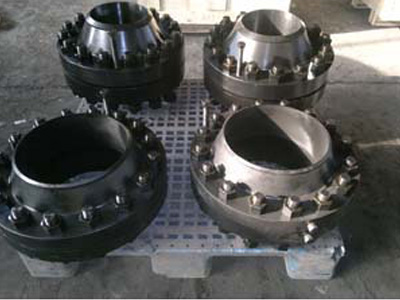
2020.7.7
For people not knowing too much about flanges, they are actually a common disc-shaped part that helps connect pipes, equipment, etc. Due to their excellent connection performance, flanges have been rapidly promoted and used in many places. But many people still have a lot of questions about them. So, today, we’ll answer some common questions one by one.
What is the connection method of a flange?
Flange connection is important for pipeline construction which is to fix two pipes, fittings or equipment to a flange firstly, then add a flange gasket between the two flanges, and fasten them together by bolts. The connection of some fittings and equipment that come with flanges also belongs to flange connection.
Flanges can be divided into threaded flanges and welded flanges. Threaded flanges are used for low pressure and small diameter circumstances while welded flanges are used for high pressure and large diameter circumstances. The thickness of the flanges of different pressures and the diameter and number of connecting bolts are different. Depending on the level of pressure, the flange gaskets are also varied from low or high pressure asbestos gaskets to metal gaskets. Connecting with flanges are easy to operate and can withstand large pressures.
Flange connections are widely used in industrial piping. If you are in a boiler room or production site, pipes and equipment that are connected with flanges can be seen everywhere. Whereas flange connection is hard to find in a home-used pipeline with a small diameter and low pressure.
What is the use of a flange?
Flanges are used for connecting pipes, valves, and other equipment. A flange can also be a plate or ring to form a rim at the end of a pipe when fastened to the pipe. Take a blind flange for an example, it is a plate for covering or closing the end of a pipe. A flange joint is a connection of pipes, where the connecting pieces have flanges by which the parts are bolted together.
What is the difference between orifice flanges and other flanges?
As we have mentioned above, normal flange connection is to fix two pipes, fittings or equipment to a flange firstly, then add a flange gasket between the two flanges, and fasten them together by bolts. While an orifice flange is a device used to measure the flow rate of liquids and gases, for reducing pressure or for restricting flow. The orifice plate is in the middle of two flanges, and the pressure is measured through the pressure measuring point on the flange and the differential pressure transmitter.
In order to ensure that the installed flange will not cause oil leakage, what factors should be paid attention to during installation?
First, the flange should have sufficient strength and should not be deformed when tightened. The flange sealing surface should be clean, and the oil and rust should be carefully removed during installation. Second, the gasket should have good oil and aging resistance, as well as good elasticity and mechanical strength. The cross-section and size of the gasket should be based on the shape of the joints, and the gasket has to be placed correctly. Third, the flange tightening force should be uniform and the compression of the rubber gasket should be controlled at about 1/3. Besides, flange maintenance is also pretty important for preventing damage caused by leakage.
What are the main principles for selecting a flange?
Slip-on flanges are used for pipes with a design temperature of 300 °C and a nominal pressure of less than or equal to 2.5 MPa. While weld neck flanges are used for pipes with a design temperature larger than 300 °C or a nominal pressure larger than or equal to 4.0 MPa.

